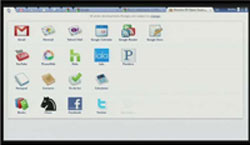News
Google Chrome OS Released as Open Source Code
Google's previously under-wraps operating system is now available to developers as open source code, the company announced on Thursday.
In an online press briefing, company officials demonstrated Google Chrome OS publicly for perhaps the first time, although the OS was initially described in July. Chrome OS is currently being designed to work on netbooks and the company is about "a year away" from launching a product, according to Sundar Pichai, Google's vice president of product management.
Chrome OS is a free open source operating system designed for use on netbooks, but it could be repurposed to run on desktops. In a Q&A, Pichai said that Google will be reviewing that possibility "in the middle of next year." The OS will run on x86 hardware, but Google also will make sure than it runs on ARM processors, according to Matt Papakipos, engineering director for Google Chrome OS.
Pichai added that Google doesn't see the OS as being limited to the rather small screen size and keyboard size of today's netbooks.
Chrome OS, which looks a lot like Google's Chrome Web browser, will work with Web applications only. People still need to work offline, and Google is developing a database API to enable offline access in the Google Chrome browser, Pichai said. In 2010, Google plans to have all of the APIs built into Chrome, he added.

[Click on image for larger view.] |
The main Chrome OS screen strongly resembles the Chrome browser. The tabs at top hold both programs and external Web links.
|
Users do not have to install applications on netbooks running Chrome OS. In fact, they can't. Instead, they just run a Web application through their browser, which sits atop Chrome OS. The OS has an applications tab in the top left corner of the screen that lists available applications. In addition, Google plans to make it easy for users to discover new Web applications.

[Click on image for larger view.] |
Clicking the top left tab in the Chrome OS takes users directly to the list of their applications hosted online (the Chrome OS does not run installed apps).
|
Applications can be pinned to the top of the OS screen in tabs. They are distinguished from Web pages because the application tabs don't close. Chrome OS also uses panels as part of the user interface. Panels are "persistent lightweight windows" that can be minimized, according to Pichai. Typical uses for panels include chat windows, applications like notepad, file management and even Google Books, which can be read in full-screen mode.
The new OS will be hardware specific. Google is currently working with its hardware partners on the specs. Pichai said that means that users will definitely have to buy a Google Chrome OS-specific device. In particular, Chrome OS will only run on machines with solid state drives (SSDs). In taking that approach, Google is bypassing a lot of the delays seen with running traditional operating systems. For instance, most OSes spend time looking for a floppy disk on bootup, Papakipos explained.
Google's demo included a laptop that quickly booted to a log-in screen. Pichai said the bootup took seven seconds, and that it takes another three seconds to log into an application. Google is working to reduce even those times. The fast bootup is made possible through the use of flash memory in the SSDs, as well as through bypassing various application background services that initially load with traditional OSes, Papakipos explained.
Google conceives of Chrome OS as a different model of personal computing and is focusing on speed, simplicity and security. Pichai said that Google wants the netbook experience to be fast, like turning on a TV. Simplicity is enabled because users don't have to install programs and there's nothing to maintain. All of the data is stored in the Internet cloud. Security is improved because users can't install binaries. The file system locks down the partition as read only. In addition, if a user loses a netbook, the data isn't lost. The user can log in via another device and have access to that data anywhere.
Chrome OS has some technologies that can help with security threats, according to Papakipos. It automatically updates itself and has a "verified boot" system that checks to see that you are "running what you should be running," he explained. It also uses a cryptographic signature key. If a problem is detected, malware detection is run. Google can also reimage the system and save the user's cache data, restoring user settings. The storage of the user's settings is always encrypted, Papakipos said.
The press briefing also spilled some details about Google Chrome, the company's Web browser. Google plans to roll out Google Chrome for the Apple Mac and Linux-based computers before the end of the year, Pichai said. He claimed that Google Chrome is "40 percent faster than [Microsoft's] IE 8" and that there are more than 40 million users of Google Chrome who use it as their primary browser.
Al Gillen, IDC's program vice president for system software, described Chrome OS as potentially "problematic and challenging" for Microsoft. However, he stressed that it's really just a limitation to the functionality that users get with a traditional rich desktop. Chrome OS is neither new nor revolutionary, he said.
"You take a standard Linux operating system and you're removing the stuff you don't need. You're locking it down and making it relatively tight and secure. That's fine, but the operating system is not revolutionary or different," Gillen said by phone. "You've got a browser that is probably optimized for some Google applications and services. But fundamentally, it's a browser on an operating system."
More details on Chrome OS can be found by reading Google's announcement here.
About the Author
Kurt Mackie is senior news producer for 1105 Media's Converge360 group.